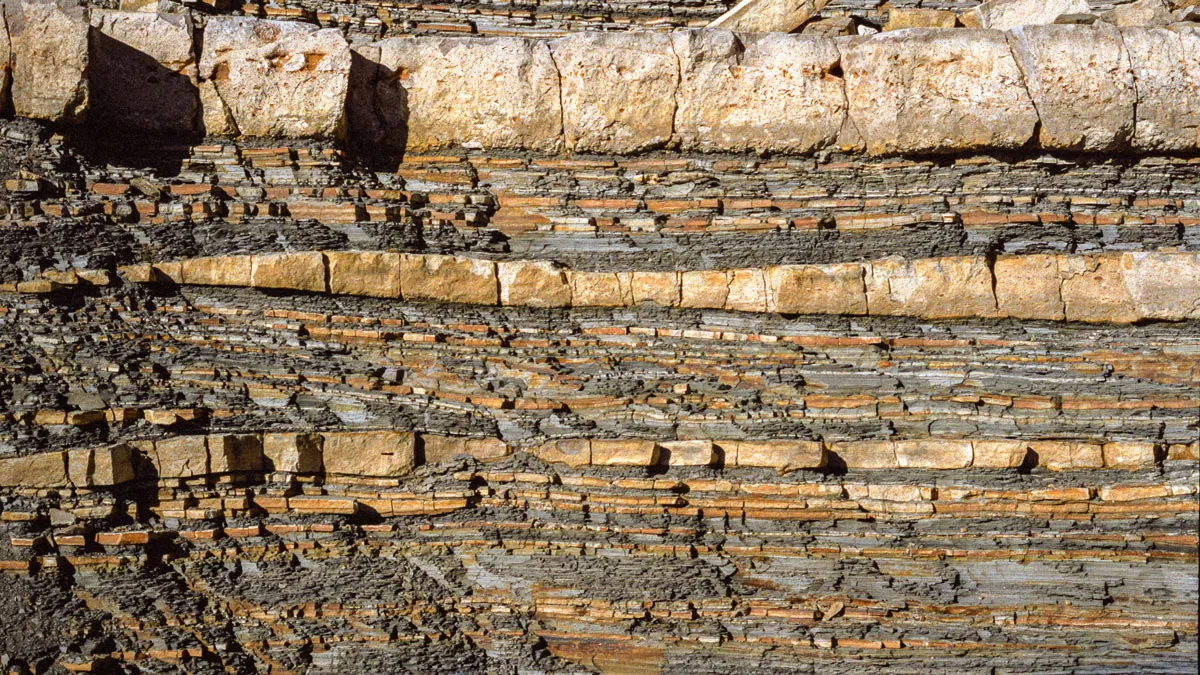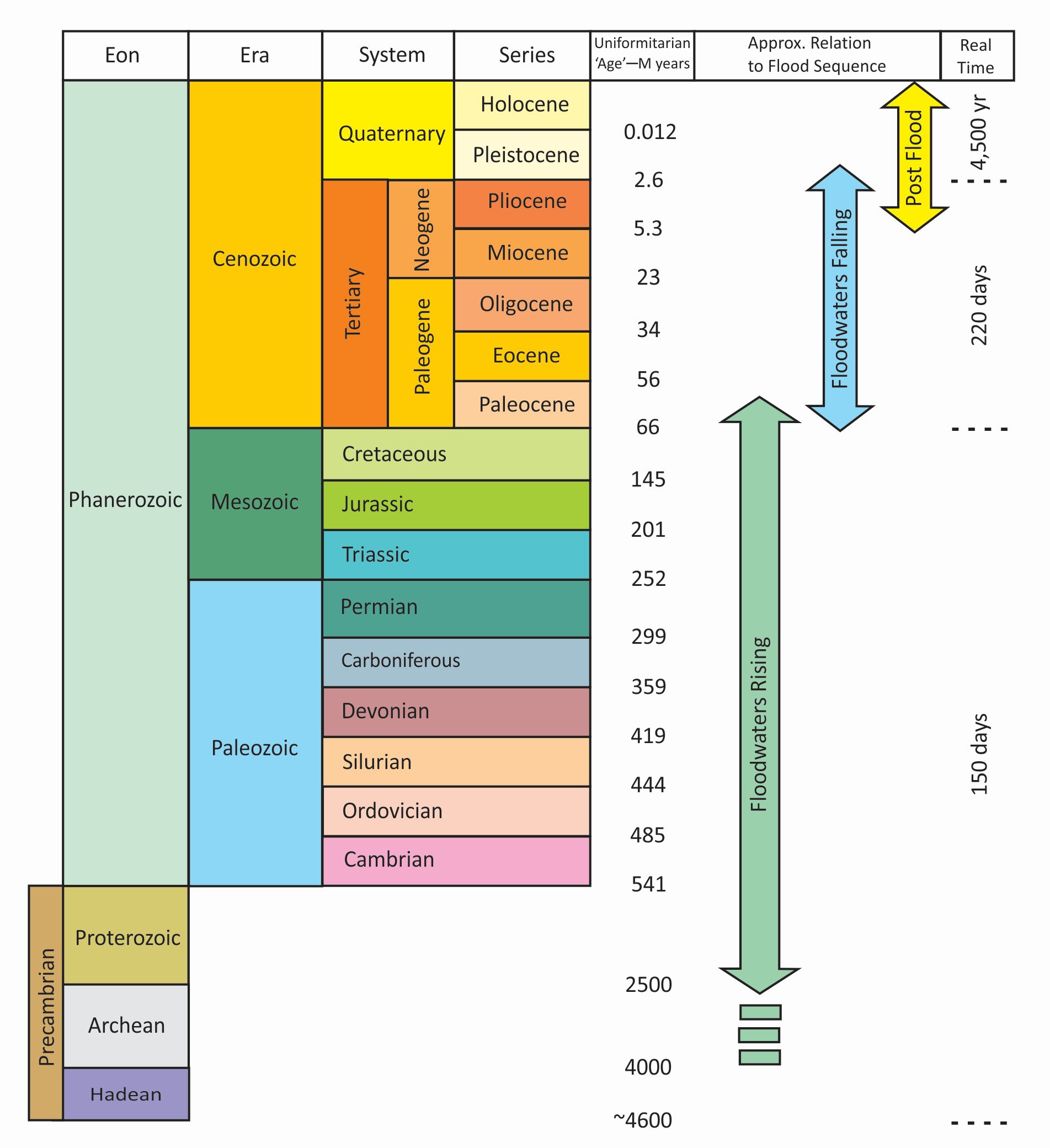Geology is the scientific study of the Earth, its composition, structure, physical properties, history, and the processes that shape it. Modern geological understanding has developed through centuries of careful observation, experimentation, and analysis. This page examines fundamental geological principles and their implications for understanding Earth's history, particularly in relation to claims about a global flood.
Basic Rock Formation Processes
Rocks form through three primary processes, each producing distinctive characteristics that geologists can identify and study:
Igneous Rocks
Igneous rocks form when molten material (magma or lava) cools and solidifies. This process creates distinctive crystalline structures that vary depending on cooling rates.
- Intrusive igneous rocks (like granite) form when magma cools slowly beneath Earth's surface, allowing large crystals to develop
- Extrusive igneous rocks (like basalt) form when lava cools rapidly on the surface, resulting in small crystals or glassy textures
Evidence Contradiction
Large intrusive formations like granite batholiths require centuries to millennia to cool and crystallize. Their presence throughout Earth's crust contradicts a single-year flood event explanation. Many igneous formations intrude into sedimentary layers, indicating they formed after sediments were already deposited.
Sedimentary Rocks
Sedimentary rocks form when particles of sediment (sand, silt, clay, organic material) are deposited in layers, compacted, and cemented together over time.
- Clastic sedimentary rocks (like sandstone, shale) form from accumulated rock and mineral fragments
- Chemical sedimentary rocks (like limestone) form when dissolved minerals precipitate from solution
- Organic sedimentary rocks (like coal) form from accumulated plant or animal remains

Clearly defined sedimentary rock layers showing different depositional environments over time
Evidence Contradiction
Sedimentary rock features that contradict a global flood model include:
- Ancient soil horizons (paleosols) preserved between rock layers, showing periods of land exposure and soil development
- Evaporite deposits (salt, gypsum) requiring long periods of evaporation in shallow, isolated basins
- Lithification processes requiring significant time for compaction and cementation
- Alternating fresh and saltwater deposits indicating changing environments over time
Metamorphic Rocks
Metamorphic rocks form when existing rocks are subjected to high heat, pressure, or chemically active fluids, causing mineralogical and textural changes without complete melting.
- Regional metamorphism affects large areas, often due to tectonic processes
- Contact metamorphism occurs when rocks are altered by nearby magma intrusions
Evidence Contradiction
Metamorphic processes require substantial time under sustained pressure and heat. Many metamorphic formations show evidence of multiple metamorphic events spanning millions of years. The geologic column contains sequences of metamorphic rocks between unaltered sedimentary layers, indicating long intervals between formation events.
Stratigraphy and the Rock Record
Stratigraphy is the study of rock layers (strata) and layering (stratification). Several key principles form the foundation of stratigraphic analysis:
Principle of Original Horizontality
Sediments are generally deposited in horizontal layers. When we find tilted or folded layers, we know they were moved after deposition, providing evidence of Earth's dynamic nature.
Principle of Superposition
In undisturbed rock sequences, younger rocks lie above older rocks. This allows geologists to determine relative ages of rock units. (Principle of Superposition)
Principle of Lateral Continuity
Sedimentary layers extend laterally until they thin or face a barrier. Matching rock units across distances helps reconstruct ancient landscapes. (Principle of Lateral Continuity)
Principle of Cross-Cutting Relationships
A geologic feature that cuts across rocks must be younger than the rocks it cuts. For example, a volcanic dike that intrudes through sedimentary layers formed after those layers. (Principle of Cross-Cutting Relationships)
Evidence Contradiction
The global rock record shows consistent patterns that challenge flood geology:
- The "geologic column" with predictable fossil succession appears consistently worldwide
- Radiometric dating shows consistent age progressions aligning with stratigraphic principles
- Cross-cutting relationships demonstrate multiple episodes of intrusion, erosion, and deposition
- Many formations show evidence of multiple cycles of sea level rise and fall
Deep Time
One of geology's most significant contributions to scientific understanding is the concept of "deep time" - the recognition that Earth's history spans billions of years, not thousands.
Multiple independent lines of evidence support an ancient Earth:
| Dating Method | What It Measures | Approximate Range |
|---|---|---|
| Radiometric Dating | Radioactive decay of isotopes | Thousands to billions of years |
| Tree Rings | Annual growth patterns | Up to ~14,000 years |
| Ice Cores | Annual ice layers | Up to ~800,000 years |
| Varves | Annual sediment layers | Up to millions of years |
| Coral Growth | Annual growth bands | Up to hundreds of thousands of years |
Evidence Contradiction
Multiple chronological methods indicate Earth's history far exceeds 6,000-10,000 years:
- Ice cores from Greenland and Antarctica contain over 800,000 annual layers
- Lake varves (annual sediment layers) in some locations exceed 20 million layers
- Tree ring chronologies extend beyond 14,000 years
- Radiometric dating consistently yields ages of millions to billions of years for appropriate rock samples
Depositional Environments and Features
Geological formations preserve evidence of the specific environments in which they formed. These features allow geologists to reconstruct ancient landscapes and conditions.
Desert Formations
Ancient desert environments are preserved in the rock record as:
- Cross-bedded sandstones showing ancient dune structures
- Evaporite minerals indicating dry conditions
- Wind-polished ventifacts and desert varnish
Glacial Deposits
Glacial processes leave distinctive signatures:
- Unsorted glacial till
- Striated and polished rock surfaces
- Dropstones in otherwise fine-grained sediments
Shallow Marine Environments
Coastal and shallow marine deposits show:
- Ripple marks from wave action
- Mud cracks from periodic exposure
- Intact fossil communities of shallow-water organisms
Evidence Contradiction
The rock record contains numerous features that could not form during a single flood event:
- Multiple massive desert sandstone formations (like the Navajo Sandstone) showing dune structures that require dry conditions
- Glacial deposits interbedded with tropical reef formations, indicating climate changes over long timescales
- In-place fossil forests at multiple levels (like Yellowstone's petrified forests), requiring time for growth between burial events
- Preserved dinosaur nests with eggs and footprint trackways that would be destroyed in catastrophic flooding
Tectonic Processes
Plate tectonics is a foundational theory in geology that explains how Earth's lithosphere is divided into plates that move relative to each other, driven by convection in the mantle.
Evidence for plate tectonics includes:
- The matching of continental margins (like Africa and South America)
- Similar rock types and ancient mountain ranges across currently separated continents
- The distribution of earthquakes and volcanoes along plate boundaries
- Magnetic striping on the ocean floor recording reversals in Earth's magnetic field
- Direct measurement of plate movement using GPS and other technologies
Evidence Contradiction
Tectonic evidence contradicting a recent global flood includes:
- Ocean floor magnetic striping indicating millions of years of seafloor spreading
- Continental drift rates (typically 2-10 cm/year) that would require millions of years to create current continental configurations
- Mountain building processes that require millions of years of compression and uplift
- Seamount chains showing progressive movement of tectonic plates over hotspots over millions of years
Fossil Record
The fossil record provides a detailed chronicle of life's history on Earth, with consistent patterns observed worldwide.
Fossil Succession
Different groups of organisms appear, diversify, and often disappear at consistent points in the geologic column worldwide:
- Microbial fossils dominate Precambrian rocks
- Marine invertebrates first appear in abundance in Cambrian rocks
- Fishes become common in Ordovician and Silurian rocks
- Land plants and animals appear in Devonian rocks
- Dinosaurs dominate Mesozoic terrestrial deposits
- Mammals diversify in Cenozoic rocks

The geologic column with the consensus dates and young earth creationist interpretation shown.
Notice the discrepancy between 4.6 billion years and 150 days of geologic time.
Evidence Contradiction
The fossil record contradicts flood geology in several ways:
- Consistent worldwide ordering of fossils that doesn't align with flood sorting mechanisms (neither ecological zonation nor hydrological sorting explains the patterns)
- Absence of modern mammals in Mesozoic rocks worldwide
- No mixing of human remains with dinosaur fossils
- Preservation of delicate structures (tracks, burrows, nests, soft tissues) that would be destroyed in catastrophic conditions
- Microfossil assemblages indicating stable ocean conditions between major boundaries
Conclusion
The basic principles of geology - rock formation processes, stratigraphy, deep time, depositional environments, tectonic processes, and the fossil record - form a cohesive framework for understanding Earth's history. These principles, developed through centuries of scientific investigation, indicate Earth has experienced a complex history spanning billions of years.
The evidence from geology shows patterns of gradual change punctuated by localized catastrophic events rather than a single global catastrophe. Multiple independent lines of evidence consistently indicate an ancient Earth with a long, complex history that cannot be compressed into a single year-long flood event.